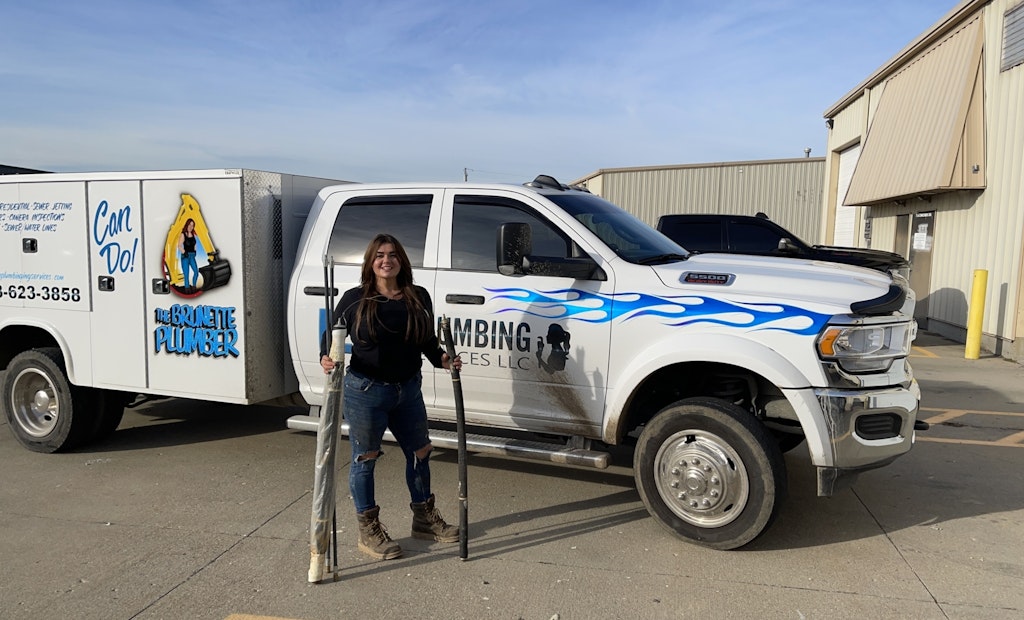Interested in Relining/Rehab?
Get Relining/Rehab articles, news and videos right in your inbox! Sign up now.
Relining/Rehab + Get AlertsThe slogan for Linda Hudek’s company, LH Plumbing Services in Fairfield, Ohio, is, “Can do.” But for years, she was frustrated by what she couldn’t do: Offer customers a trenchless solution for pipe repairs.
“It definitely sucked,” says Hudek, who established the company in 2010. “Some people just don’t have that kind of money for excavating a pipe — it’s not the kind of thing you plan for or budget for. I never liked telling people their only option was digging, that’s for sure.”
But that all changed about four years ago when Hudek learned about the PipePatch spot repair system from Source One Environmental (S1E). It works similar to the way a stent restores good blood flow in a clogged artery.
“It’s a good compromise between not being able to offer customers anything but excavation and full-scale pipe lining, which I can’t do as a one-person operation,” Hudek says. “It’s also a great option for people with just one area of a pipe that’s problematic. And it’s an immediate fix — something that I can do much faster than a full dig. I can be in and out in less than a day with the PipePatch.”
The fiberglass liners, or mats, come in 2- or 4-foot lengths and will fit pipe diameters ranging from 1-1/2 to 72 inches. But mats also can be installed end-to-end, with small overlaps, to cover distances longer than 4 feet. When fully cured, the patch is only about 1/8-inch thick, so the host pipe maintains nearly all of its original diameter.
Aside from the patches, the system’s basic components are a pre-measured, two-part epoxy resin; a reusable, inflatable, bladder-like device called a “packer;” and flexible pushrods with quick-disconnects on both ends. The packers and pushrods are sold separately from patch repair kits.
A thoroughly cleaned pipe is essential to a successful installation. If descaling is needed, Hudek uses an Elite Soldier trailer jetter (4,000 psi at up to 10 gpm) built by Spartan Tool.
Hudek also inspects lines after cleaning and uses a camera to pinpoint the distance to the patch area, which will determine how many pushrods she’ll need.
As a precaution, Hudek says she always does a test run first with just the packer, just to be sure she can maneuver it to the repair spot without any problems.
“You need to do a dry run every time,” she says. “I also put the packer into a short section of pipe that’s the same diameter as the pipe I’m patching, then inflate it so that I know the approximate psi level I’ll need to reach. This is helpful because when the packer is inside the pipe, you can’t see it inflating.”
After attaching enough pushrods, Hudek marks one with a piece of tape to indicate how far in she needs to go in order to reach the repair spot. Then she mixes the pre-measured two-part epoxy resin and uses an included tool to fully wet-out the fiberglass mat. She follows instructions for folding up the mat, wraps it around the packer and uses included wire twist-ties to tightly secure the mat to the packer. Time is of the essence, she says.
“After the resin is mixed, the clock starts running,” says Hudek. “There’s a quick-set resin that sets up in seven minutes, but I use one that gives you about 20 minutes. The hotter it is, the less time you have and the faster it cures; if it’s cooler, you have a little more time to work with and curing takes a little longer.”
Hudek then inserts the packer into the pipe, following by a camera that can verify the packer is in the correct spot. Next, she inflates the packer. As the packer slowly blows up, the metal twist-ties pop off, allowing the patch to expand and conform to the host pipe, with the packer maintaining pressure. After letting the packer sit for the required curing time (which varies by pipe diameter and air temperature), Hudek deflates the packer and removes it.
“Then I camera the line again to make sure the patch adhered well and is smooth,” she says. “A failed patch can be a real problem because the fiberglass mat is really hard and difficult to remove — you’d need to use a milling machine. But I’ve installed about 20 patches and that’s never happened to me yet.”
While installation may sound complicated, it’s really not, Hudek says. A Source One rep came to her shop and showed her how to do it. Later, she did her first installation without a hitch. Following installation instructions is critical.
“You just have to fully understand how everything works, take your time and think about every individual step, plus make sure you have everything you need before you start,” she says.
Hudek loves how the PipePatch enables her to provide customers with a trenchless solution that’s also significantly less expensive than conventional excavation.
“PipePatch has helped me provide solutions for customers in unique situations where traditional excavation is not an option or is extremely expensive,” she says. “As a result, it’s made me the ‘can-do’ plumber for many customers who thought their options were limited to traditional methods.”






